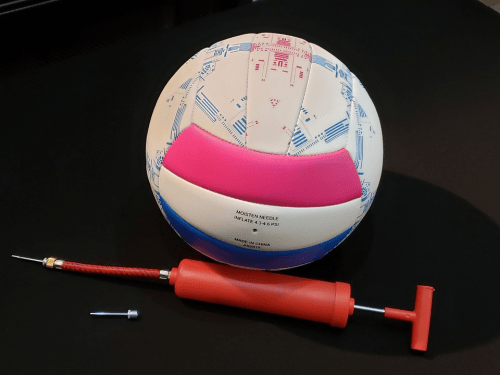Early Volleyball Equipment

Early Volleyball Equipment: Evolution from Basics to Modern Gear
Volleyball has grown immensely in popularity since its invention in 1895 by William G. Morgan, a YMCA physical education instructor in Holyoke, Massachusetts. Initially created as an alternative to basketball, volleyball was designed to be a low impact activity suitable for older participants.
But over the years, volleyball transformed from a casual YMCA activity to an Olympic sport with high intensity competition. This journey not only reshaped the game itself but also drove significant evolution in the equipment used. Here’s a look at the history of volleyball equipment, from its early rudimentary tools to today’s advanced, specialized gear.
The First Volleyball and Net (1895-1900s)
When volleyball was first invented, there was no official volleyball; the game’s equipment was pieced together with what was available. Morgan used a standard tennis net, raised to a height of 6 feet 6 inches, as the original volleyball net. Tennis nets, however, were not ideal, and as volleyball gained popularity, the need for a more suitable net became evident.
As for the ball, the first volleyball was simply a basketball bladder (the inner, inflatable part of a basketball), which was relatively soft but still heavier and harder to control than modern volleyballs. This made the game challenging and impacted the playstyle, as the ball was difficult to spike or set.
The Development of the First Volleyball (Early 1900s)
By 1900, demand for a ball specifically designed for volleyball prompted the A.G. Spalding company to create the first official volleyball.
This ball was lighter than the basketball bladder and had a leather outer layer with a rubber bladder inside, making it easier to hit, control, and keep in play. Its design allowed players to serve and spike with more accuracy, helping to shape the style of the game as we know it.
The standard size and weight of volleyballs were later established, with the ball typically measuring about 25-27 inches in circumference and weighing 260-280 grams. This became the first official volleyball that provided a consistent feel for players, which was essential for both skill development and fair competition.
The Net Evolves (1930s-1950s)
As volleyball became more competitive, the equipment evolved to accommodate the faster pace of play. Nets were standardized, and the height was adjusted to 7 feet 11 5/8 inches for men and 7 feet 4 1/8 inches for women. This adjustment created a fair balance between offense and defense.
During this period, beach volleyball also emerged, necessitating modifications to the net to handle outdoor conditions. Beach volleyball nets were made sturdier and more weather resistant. By the 1950s, with volleyball’s rise in popularity both indoors and on the beach, the nets used began to reflect the differing requirements of each environment.
Advancements in Volleyball Design (1960s-1970s)
The 1960s marked a turning point in volleyball as technological advances in materials made equipment lighter and more durable. The classic leather volleyball gave way to balls that used synthetic materials to improve durability and water resistance, which was especially valuable for beach volleyball.
The use of synthetic materials also allowed for better air retention and shape consistency. These advances ensured the ball’s performance remained predictable, even under heavy use. By the 1970s, volleyball equipment was becoming more specialized, with separate designs for indoor and beach volleyball balls.
Beach volleyballs were slightly larger and had a softer feel, making them better suited for the sand and wind conditions of outdoor play.
Introduction of Protective Gear (1980s-1990s)
With the popularity of volleyball booming, players started investing in protective gear as the sport demanded greater physicality. Knee pads, which had not been part of early volleyball, became essential to prevent injuries from diving and sliding on the court.
The 1980s saw the development of specialized volleyball knee pads with gel or foam padding, which offered both protection and flexibility.
Shoes also began to be designed specifically for volleyball. These volleyball specific shoes provided support and grip suited to the quick, multidirectional movements unique to the sport. The soles were made of non marking rubber to prevent court damage, while the uppers used lightweight materials that allowed for optimal agility and stability.
Modern Volleyballs and Nets (2000s-Present)
Volleyballs continued to evolve, with synthetic leather becoming the standard for both indoor and outdoor play. The panels on volleyballs were redesigned to create more predictable flight patterns and improve aerodynamics.
Modern volleyballs have a distinct panel pattern that is engineered to give the ball a truer flight path and are water resistant, especially crucial for beach volleyball.
Additionally, the balls were manufactured with vibrant colors to increase visibility, especially important for televised games and outdoor settings. The Federation Internationale de Volleyball (FIVB) and the AVP (Association of Volleyball Professionals) regulated ball colors and designs to ensure visibility and standardization across competitions.
Nets in the modern era have become even more specialized. Indoor volleyball nets now use high tensile fibers that ensure they remain taut during play, while beach volleyball nets are designed to withstand the rigors of sand and sun exposure, using materials that resist both saltwater and UV damage.
Technological Integration in Volleyball Equipment
In recent years, volleyball has seen a technological revolution, with equipment like smart volleyballs entering the market. These volleyballs come with built in sensors that track data like speed, spin, and impact, allowing players and coaches to analyze their game with unprecedented detail.
This technology is used in training to improve player performance and increase the effectiveness of drills.
Additionally, volleyball courts now use video assisted referee (VAR) systems and sensors embedded in the court to accurately detect faults, line calls, and touches. This technology has revolutionized the way the game is officiated, making it fairer and more precise.
The Impact of Volleyball Equipment Evolution on the Game
The evolution of volleyball equipment has transformed the way the game is played. Early volleyballs and nets were rudimentary, limiting players’ abilities to perform advanced maneuvers. But as equipment improved, new techniques and styles of play emerged.
Today, spiking, blocking, and setting are integral parts of the game, enabled by the refined design of balls and nets. Advanced protective gear and footwear have also allowed players to push the boundaries of athleticism while minimizing injury risks.
The development of volleyball specific technology has further elevated the sport by providing players and coaches with tools to analyze and refine performance. These technological advancements, alongside the evolution of traditional equipment, have shaped volleyball into a fast paced, competitive, and strategically complex sport enjoyed by millions worldwide.
In Conclusion
The evolution of volleyball equipment from its early makeshift days to today’s highly specialized gear tells a story of the sport’s growth and the increasing demands on players and equipment.
From basketball bladders and tennis nets to technologically advanced volleyballs and nets designed to withstand outdoor conditions, each advancement has brought new possibilities and challenges to the sport. Volleyball equipment will continue to evolve as technology advances, promising even more exciting innovations for future generations of players and fans alike.


